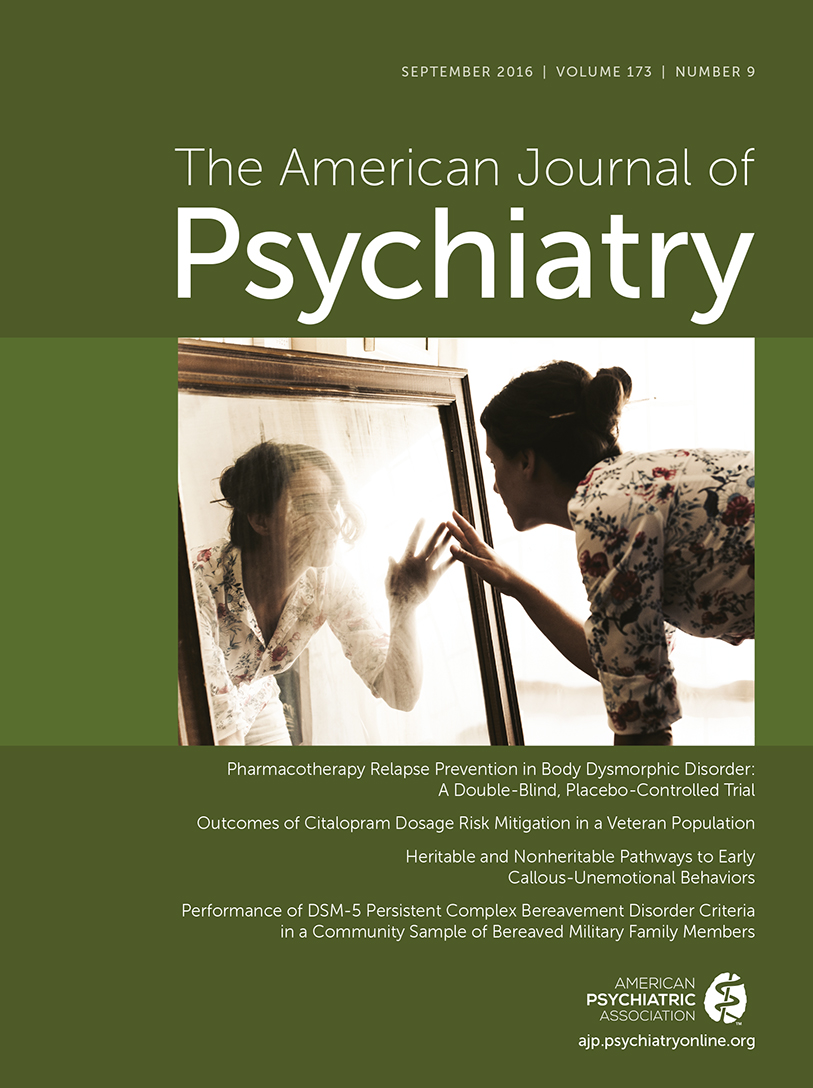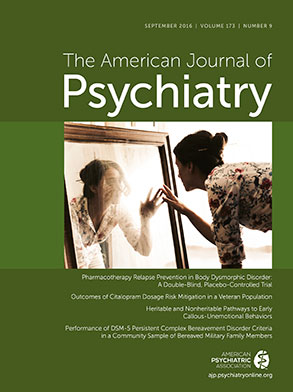“First do no harm” is one of the most revered canons of medical practice and of health policy, but it is easier to endorse in principle than to implement in practice. The study by Rector et al. (
1), published in this issue of the
Journal, attests to this difficulty by reminding us not only of the need to beware of unintended consequences of treatment but also to beware of unintended consequences of initiatives to avoid unintended consequences. Rector et al. studied the outcome of guidance issued in 2011 by the Food and Drug Administration (FDA) discouraging dosages of more than 60 mg/day of citalopram (
2) to minimize the risk of QT prolongation and of potentially fatal cardiac arrhythmias. This guidance quickly elicited a corresponding directive from the VHA, which treated almost 300,000 veterans for major depression that year. Rector et al. used VHA’s rich national administrative data to demonstrate that of 35,848 veterans taking 60 mg/day of citalopram, dosing had been reduced for 60% within only 6 months. They further found that citalopram dosage reductions seem to have resulted in more than a fourfold increase in the risk of overall hospitalization (especially for mental health diagnoses) or death, with a doubling of hospitalization specifically for depression or death. In contrast, no significant reduction was observed in hospitalizations specifically for cardiac arrhythmias or all-cause death. This sophisticated observational data analysis is subject to the many caveats that go with nonexperimental comparisons, but this research seems to have uncovered an unexpected, unintended consequence. We cannot determine whether the observed increase in hospitalizations following the lowering of dosages resulted from inadequately dosed antidepressant treatment of underlying depressive disorder (which seems unlikely), or from a discontinuation syndrome from high dosages (
3) (which seems somewhat more probable). If the latter, the policy caused a one-time set of adverse events, unlikely to be repeated. If the former, the policy-related problem of undertreatment is likely to endure.
Two years after the VHA policy change, another study using U.S. Department of Veterans Affairs (VA) administrative data looked for adverse cardiac events associated with high dosages of citalopram in comparison with sertraline in almost one million patients and found no evidence of any greater risk for arrhythmia or all-cause cardiac or noncardiac mortality (
4). A similar finding was also reported from a similar analysis of Medicaid data (
5). Thus, a policy apparently based only on suggestive ECG changes resulted in a change in practice that, far from reducing expected harm, incurred other, unanticipated harms, while subsequent research presented evidence that undermined the justification for the original policy altogether.
This briefly summarized policy tale exemplifies the difficulty of differentiating true health risks from misleading suggestions from proxy indicators; the potential effectiveness (or, perhaps in this case, overeffectiveness) of risk-related practice regulation in large health care organizations; and the value of sophisticated “big data” risk analyses available in systems like the VHA, when funding for in-depth health services research is available as part of health system operation. This story further illustrates the potentially troublesome function of what legal scholars call the “precautionary principle,” whereby even in the absence of robust risk data, suggestive information generates sufficient fear so that action is taken to eliminate merely “possible” risks (
6).
Citalopram was approved for the treatment of major depressive disorder almost 20 years ago and has been identified as among the more effective and best tolerated antidepressants (
7). A review of both published and unpublished randomized trials of citalopram appearing in the
New England Journal of Medicine (
8) reported that while published studies of citalopram for major depressive disorder suggest a small to moderate effect size of 0.30, the addition of unpublished studies on file at the FDA results in a decline in effect size by 20% to 0.24, revealing a benefit that would be considered small. Thus, the trial-based risk-benefit calculus for citalopram met FDA criteria for marketing but does not appear to be robustly favorable.
In the summer of 2011, the FDA determined on the basis of ECG data from an unknown number of patients that “[c]italopram causes dose-dependent QT interval prolongation, which can lead to serious cardiac arrhythmias and a risk of death” (
2), which is a presumably rare outcome that seems never to have been observed but that evoked fear of the most disastrous adverse outcome. With no data to either quantify the magnitude of the risk or weigh it against the potential, if unlikely, benefits of high citalopram dosages for some patients, and perhaps considering the evidence suggesting only weak benefits for citalopram in the first place, the FDA decided that citalopram should no longer be prescribed at dosages of 60 mg/day. Thus, this decision seems to reflect an abundance of caution in the presence of virtually no credible risk-benefit calculus but rather represents an active policy response to a frightening suggestion of merely possible disastrous harm.
Only a few weeks later, the VHA issued a national bulletin stating that “providers should refrain from prescribing citalopram in doses that exceed those in its label” and that, when possible, “providers should attempt to reduce doses in patients whose current dose exceeds” 40 mg (
9). The bulletin added that the VHA recognized that some patients might require higher dosages, although no evidence for this assertion was presented, and none could be found for this editorial. The VA guidance then listed eight steps to be taken when considering prescribing higher dosages, including ECG analysis, laboratory tests, and continued assessment of the need for higher dosing. This complex guidance seems to reflect both a sense of urgency about responding to the FDA alert and a conflicting desire not to unduly constrain physician prescribing in the face of weak evidence, and it demonstrates a high level of caution by imposing a tangle of procedures that would be cumbersome to fulfill. The final policy thus expressed the poorly justified caution linked with ambivalent constraints on physician prescribing—an understandably muddled response to frightening but inadequate data.
Stepping back to take a broad view of this policy process, one infers that the implicit reasoning underlying this decision, and many others like it, was that in the absence of adequate data, a frightening possibility demanded an effort to eliminate the possibility of iatrogenic death. The ultimate adverse outcome for depressed patients could not have been foreseen, but from the perspective of hindsight, the policy represented excessive and, in the end, somewhat harmful cautiousness.
Cautionary zeal, however poorly justified, is not incomprehensible or unexpected and has been famously studied by the Nobel Prize–winning psychologist Daniel Kahneman (
10) and other behavioral economists (
11), for whom it exemplifies a characteristic, if irrational, human tendency toward “risk aversion” and an embrace of the precautionary principle. This implicit, typically unstated principle demands elimination of any action that may lead to any harm, even in the absence of substantive evidence. Cass Sunstein, one of many students of predictably irrational decision making, has shown how the exercise of the precautionary principle “is paralyzing—forbidding inaction, [and] demanding stringent regulation” (
6). Understanding the basis for irrational behavior, as Sunstein and others suggest, does not make such behavior any less compelling. The present cautionary tale alerts us to the fact that adherence to the precautionary principle, compelling as it may be, especially in the absence of adequate information, may itself lead to unanticipated harms. Following the example of Rector et al., perhaps the best we can do is be on the lookout for such harms and minimize their impact as best we can.

